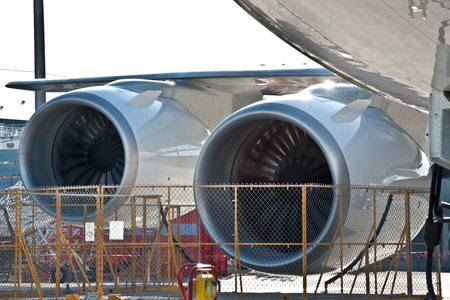
NEWSROOM
 |
NEWSROOM |
|
|
|
|
|||
|
Mike Mitchell |
||||
 |
December 10, 2009 - Boeing successfully completed the first engine runs
for the 747-8 Freighter. The milestone marks another step in the 747
program's steady progress in preparing for flight test.
Engine runs began slightly before 10 a.m. on Tuesday. During initial
engine runs, the engines are started and operated at various power
settings to ensure all systems perform as expected. The test began with
the auxiliary power system providing power to start the first of four
General Electric GEnx-2B engines. The remaining three engines were
started using the cross-bleed function. Basic systems checks continued
throughout the test.
|
|||
|
The Boeing 747-8 Intercontinental and 747-8 Freighter are the new
high-capacity 747s that offer airlines the lowest operating costs and
best economics of any large passenger or freighter airplane, while
providing enhanced environmental performance.
Boeing launched the airplane on November 14, 2005, with firm orders for
18 747-8 Freighters; 10 from Cargolux of Luxembourg and eight from
Nippon Cargo Airlines of Japan. The combined list price value of the
orders is approximately $5 billion. |
||||
|
Both the passenger and freighter versions of the 747-8 will allow
operators to maximize their profitability. Seat-mile costs for the 747-8
Intercontinental are 13 percent lower than the 747-400, with 2% lower
trip costs. The 747-8 Intercontinental is more than 10 percent lighter
per seat than the A380 and consumes 11 percent less fuel per passenger.
That translates into a trip-cost reduction of 21 percent and a seat-mile
cost reduction of more than 6 percent compared to the A380.
The 747-8 family provides new revenue opportunities that will allow
airlines to maximize profits. For example, the passenger airplane has 51
additional seats to accommodate 467 passengers in a typical three-class
configuration and also offers 26 percent more cargo volume. The 747-8
Freighter offers a range of 8,130 km (4,390 nmi) and has 16 percent more
cargo volume than the 747-400, which allows it to hold seven additional
pallets with the same nose-door loading capability, industry-standard 3
m (10-ft)-high pallets and real-world cargo density capability at 159
kg/cu m or 9.9 lb/cu ft.
With a maximum structural payload capacity of 140 tonnes (154 tons) the
747-8 Freighter offers 16 percent more revenue cargo volume than the
747-400F. The additional 120 cu m (4,245 cu ft) of volume mean the
airplane can accommodate four additional main-deck pallets and three
additional lower-hold pallets. The 747-8 Freighter enables operators to
choose between carrying greater revenue payload -- up to an additional
20 tonnes (22 tons) -- or flying up to 1,400 nmi farther in markets
where cargo density requirements are lower. The airplane upholds its
predecessor's legendary efficiency, with nearly equivalent trip costs
and 16 percent lower ton-mile costs than the 747-400F. In fact, the
747-8 Freighter will enjoy the lowest ton-mile costs of any freighter,
giving operators unmatched profit potential. |
| ?AvStop Online Magazine Contact Us Return To News |
|